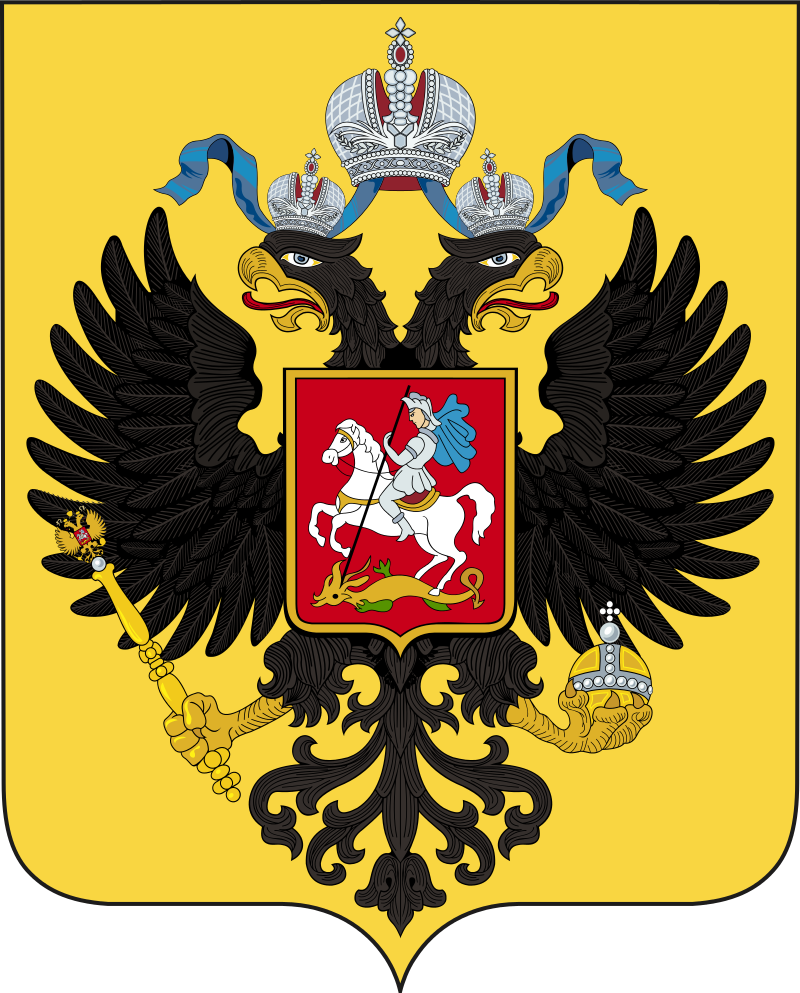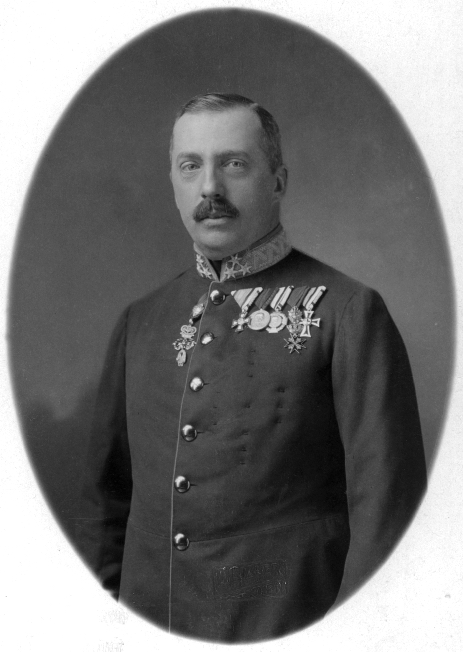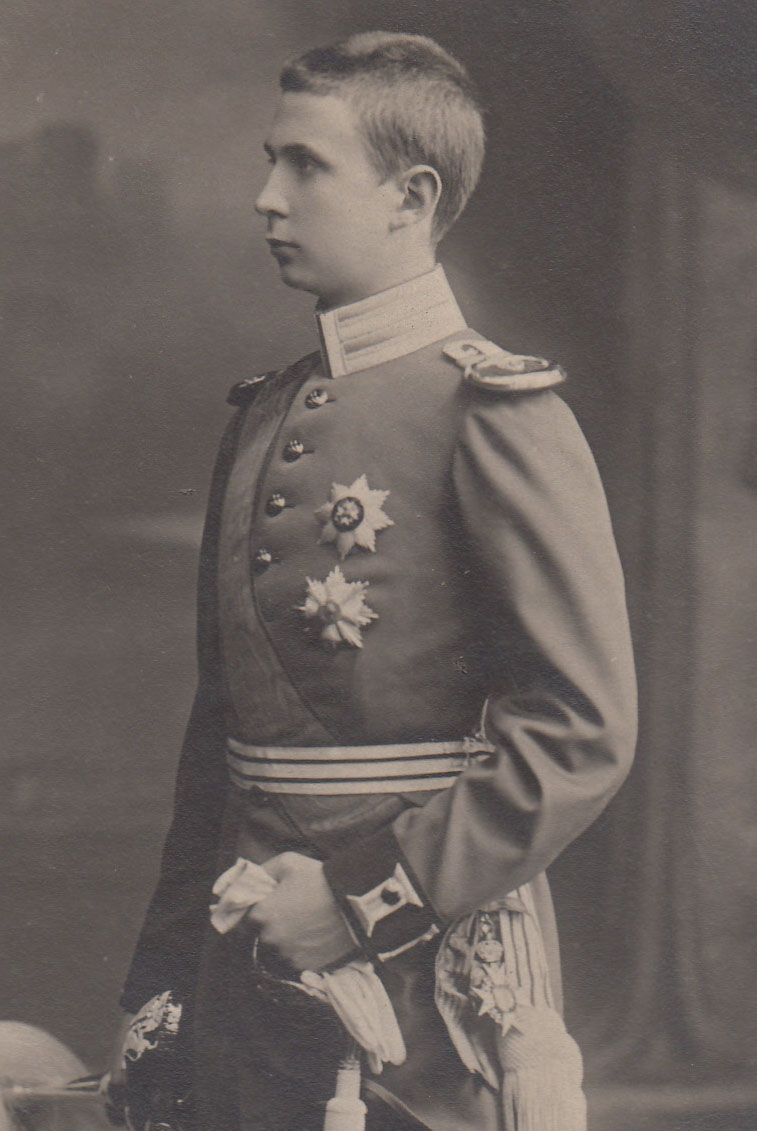by Susan Flantzer
© Unofficial Royalty 2023
Grand Duke Vladimir Kirillovich of Russia in 1938
Grand Duke Vladimir Kirillovich of Russia was the pretender to the throne of Russia from 1938 – 1992.
About the Russian Succession

Russian Imperial Coat of Arms; Credit – Wikipedia
The succession to the former Russian throne has been in dispute, mainly due to disagreements over the validity of marriages. In 1924, after Grand Duke Michael Alexandrovich (son of Alexander III, Emperor of All Russia and brother of Nicholas II, Emperor of All Russia) was declared legally dead, Grand Duke Kirill Vladimirovich, a male-line grandson of Alexander II, Emperor of All Russia, declared himself Guardian of the Throne and later assumed the title Emperor of All Russia. In 1938, upon the death of Kirill Vladimirovich, his son, Grand Duke Vladimir Kirillovich, assumed the Headship of the Russian Imperial Family.
Vladimir Kirillovich’s only child, Grand Duchess Maria Vladimirovna (born 1953), claims to have succeeded her father upon his death in 1992. Her claim to the Headship of the Russian Imperial Family is based on a claim that all male lines of the Romanov family are either extinct, illegitimate, or morganatic, triggering semi-salic succession, and that she is the closest female to the last dynast. The claim of Maria Vladimirovna as Head of the Russian Imperial Family is disputed by the Romanov Family Association, made up of the majority of the male-line descendants of Nicholas I, Emperor of All Russia. Grand Duchess Maria Vladimirovna and father Grand Duke Vladimir Kirillovich, male-line descendants of Nicholas I, never joined.
Pre-revolutionary Romanov house law allowed only those born of an equal marriage between a Romanov dynast and a member of a royal or sovereign house to be in the line of succession to the Russian throne. The throne could only pass to a female and through the female line upon the extinction of all legitimate male dynasts.
Maria Vladimiovna’s mother, Princess Leonida of Bagration, belonged to a family that had been kings in Georgia from medieval times until the early 19th century. However, no male line ancestor of Leonida had reigned as a king in Georgia since 1505, and her branch of the Bagrations, the House of Mukhrani, had been naturalized as non-ruling nobility of Russia after Georgia was annexed to the Russian Empire in 1801. Prince Karl Emich of Leiningen, another pretender, and his supporters, the Monarchist Party of Russia, argue that there is a precedent for a marriage with the House of Bagration-Mukhrani being an unequal marriage. They argue that the House of Bragation-Mukhrani, the house of Leonida Bagration-Mukhrani, Maria Vladimirovna’s mother, did not possess sovereign status and was not recognized as an equal marriage by Nicholas II, Emperor of All Russia, for the purpose of dynastic marriages at the time of the marriage of Princess Tatiana Konstantinovna of Russia and Prince Konstantine Bragation-Mukhrani in 1911, thirty-seven years before the marriage of Princess Leonida of Bragation-Mukhrani and Grand Duke Vladimir Kirillovich. The couple married, but Princess Tatiana Konstantinovna was required to renounce her rights to the Russian throne, and she was no longer a member of the House of Romanov.
Therefore, after the death of Vladimir Kirillovich in 1992, Prince Nicholas Romanov claimed he was the Head of the Imperial Family of Russia. Except for Grand Duchess Maria Vladimirovna, who said that the marriage of Nicholas’ parents was not in conformity with the house laws, Nicholas was recognized by the rest of the family as head of the Romanov family. However, Maria Vladimirovna seems to be more accepted by European royalty, and she is sometimes invited to royal events. She attended the 2023 funeral of former King Constantine II of Greece.
*******************
Grand Duke Vladimir Kirillovich of Russia was born on August 30, 1917, in Porvoo, Grand Duchy of Finland, Russian Empire, now in Finland. He was the third of the three children and the only son of first cousins Grand Duke Kirill Vladimirovich of Russia and Princess Victoria Melita of Edinburgh and Saxe-Coburg and Gotha, a granddaughter of both Queen Victoria of the United Kingdom and Alexander, Emperor II of All Russia. Vladimir’s paternal grandparents were Grand Duke Vladimir Alexandrovich of Russia (son of Alexander II, Emperor of All Russia) and Duchess Marie of Mecklenburg-Schwerin. His maternal grandparents were Prince Alfred, Duke of Edinburgh, Duke of Saxe-Coburg and Gotha (son of Queen Victoria) and Grand Duchess Maria Alexandrovna of Russia (daughter of Alexander II, Emperor of All Russia).

Vladimir’s family: (left to right) Maria Kirillovna, Victoria Melita, Kirill Vladimirovich holding Vladimir Kirillovich, and Kira Kirillovna; Credit – Wikipedia
Vladimir had two older sisters:
Vladimir had one half-sister from his mother’s first marriage, which ended in divorce, to her first cousin, Grand Duke Ernst Ludwig of Hesse and by Rhine:
Soon after the abdication of Nicholas II, Emperor of All Russia in March 1917, Vladimir’s parents Kirill and Victoria Melita, known in Russia as Grand Duchess Victoria Feodorovna, decided it was best to leave Russia. Victoria Melita was pregnant with Vladimir. They traveled to Finland, then part of Russia, where Vladimir was born on August 30, 1917. In the fall of 1919, they moved to Germany, where they reunited with Vladimir’s maternal grandmother Grand Duchess Maria Alexandrovna of Russia, the widow of Prince Alfred, Duke of Edinburgh, Duke of Saxe-Coburg and Gotha.
After the death of Victoria Melita’s mother in 1920, Kirill and Victoria Melita now had two homes at their disposal, a villa in Nice, France and the Villa Edinburg, which later became known as the Kirill Palace, in Coburg, formerly in the Duchy of Saxe-Coburg and Gotha, now in Bavaria, Germany. For the next several years, the family split their time between the two homes. In 1924, when Kirill assumed the title Emperor of All Russia, he granted Vladimir the style Imperial Highness and the titles Grand Duke and Tsesarevich (heir apparent). In 1926, the family moved for the last time, purchasing a villa in Saint-Briac-sur-Mer on the coast of Brittany in France. Here the family settled into a quiet life, while Victoria Melita put her energies into raising her son Vladimir, and ensuring her two daughters made significant marriages.

Vladimir’s family in 1926: (left to right) Vladimir Kirillovich, Victoria Melita, Kira Kirillovna, Kirill Vladimirovich; Credit – Wikipedia
Vladimir was educated privately and was fluent in Russian, English, French, German, and Spanish. He lived in London, England for a period of time, studying at the University of London. Vladimir’s mother, Victoria Melita, suffered a stroke in February 1936, while attending the christening of her fifth grandchild, and died on March 1, 1936.
Vladimir (in the center) in Paris, France in 1938
Upon the death of his father Kirill on October 12, 1938, the 21-year-old Vladimir was recognized as the Head of the Russian Imperial House by the Grand Dukes and Princes of Imperial Blood behind him in order of dynastic seniority and by the majority of the reigning houses of Europe. Unlike his father, Vladimir did not proclaim himself Emperor of All Russia. Instead, he used the style and title His Imperial Highness The Sovereign Grand Duke for the rest of his life.
During World War II, Vladimir lived in the family villa in Saint-Briac-sur-Mer on the coast of Brittany in France. However, in 1944, the Germans, who had occupied the area, feared the Allies might invade the Brittany coast, Vladimir and other family members were moved to the interior of France. When the interior of France was deemed unsafe, Vladimir and family members were allowed to move to Amorbach Castle in Amorbach, Bavaria, Germany, which had long belonged to the family of Vladimir’s brother-in-law Karl, 6th Prince of Leiningen.
After Germany’s defeat in World War II, Vladimir feared that he might be captured by the Soviet army. For his safety from the Soviets, Vladimir wanted to settle in Liechtenstein or Switzerland. However, neither country would give him an entrance visa. Vladimir’s maternal aunt, Princess Beatrice of Edinburgh and Saxe-Coburg and Gotha, had married Infante Alfonso of Spain, Duke of Galliera, the first cousin of King Alfonso XIII of Spain. Beatrice was able to obtain a Spanish visa for Vladimir. After living with his aunt at her estate El Botánico in Sanlúcar de Barrameda, Spain, Vladimir settled in Madrid, Spain, but frequently visited the family villa in Saint-Briac-sur-Mer, Brittany, France, and Paris, France.

Princess Leonida Georgievna Bagration-Mukhrani; Credit – Wikipedia
Vladimir first met his future wife, Princess Leonida Georgievna Bagration-Mukhrani, at a restaurant in Paris, France during World War II. They did not meet again until they were both staying in Sanlúcar de Barrameda, Spain. Leonida was the daughter of Prince George Alexandrovich Bagration-Mukhrani, a Georgian nobleman, and Elena Sigismundovna Zlotnitskaya, the daughter of a Russian nobleman of Polish origin. Leonida had been married to Sumner Moore Kirby, a wealthy American in 1934. They had one daughter Helen Louise Kirby, and divorced after three years of marriage. Vladimir and Leonida were married on August 13, 1948, at St. Gerasimus Orthodox Church in Lausanne, Switzerland.
Vladimir and Leonida had one daughter:
Pre-revolutionary Romanov house law allowed only those born of an equal marriage between a Romanov dynast and a member of a royal or sovereign house to be in the line of succession to the Russian throne. Princess Leonida of Bagration belonged to a family that had been kings in Georgia from medieval times until the early 19th century. However, no male line ancestor of Leonida had reigned as a king in Georgia since 1505, and her branch of the Bagrations, the House of Mukhrani, had been naturalized as non-ruling nobility of Russia after Georgia was annexed to the Russian Empire in 1801. There is controversy as to whether Vladimir’s marriage to Leonida was equal or morganatic.
By the end of Vladimir’s life, there were no longer members of the Russian Imperial House in the male line who were not in unequal, dynastic marriages. Children from such marriages, according to the laws of the Russian Empire and the Institution of the Russian Imperial Family, are not members of the Russian Imperial House. Vladimir declared his daughter Maria Vladimirovna was born from an equal marriage and that she was his heiress.
Vladimir and his wife Leonida visiting St. Petersburg, Russia in 1991
After the Soviet Union fell in 1991, Vladimir was the first member of the Russian Imperial Family to visit Russia. Upon arriving, as he set foot on the land of his ancestors, where he had never been, he was moved to tears.
Funeral of Grand Duke Vladimir Kirillovich
Vladimir frequently traveled to the United States. On April 21, 1992, Grand Duke Vladimir Kirillovich died from a heart attack at the age of 74 while addressing a gathering of Spanish-speaking bankers and investors at Northern Trust Bank in Miami, Florida. Vladimir was buried in the Grand Ducal Mausoleum at the Peter and Paul Fortress in St. Petersburg, Russia, the first Romanov buried in Russia since the Russian Revolution. At that time, it was noted in the Russian press, that the funeral “was regarded by civic and Russian authorities as an obligation to the Romanov family rather than a step toward restoration of the monarchy.”

Grave of Grand Duke Vladimir Kirillovich of Russia; Credit – www.findagrave.com The inscription reads: His Imperial Highness the Blessed Grand Duke Vladimir Kirillovich Born in Borgo, 1917 August 30th Died in Miami, 1992 April 21st Interred 1993 May 29th
After the death of Grand Duke Vladimir Kirillovich, his only child, Grand Duchess Maria Vladimirovna, claims to have succeeded her father. Her claim to the Headship of the Russian Imperial Family is based on a claim that all male lines of the Romanov family are either extinct, illegitimate, or morganatic, triggering semi-salic succession, and that she is the closest female to the last dynast. Maria Vladimirovna’s claim is disputed by the Romanov Family Association, a private organization of living male-line descendants of Paul I, Emperor of All Russia (except Maria Vladimirovna and her son). Prince Nicholas Romanov claimed that he was the Head of the Russian Imperial Family. Except for Grand Duchess Maria Vladimirovna, who said that the marriage of Nicholas’ parents was not in conformity with the house laws, Nicholas was recognized by the rest of the Romanov family as the Head of the Russian Imperial Family.
This article is the intellectual property of Unofficial Royalty and is NOT TO BE COPIED, EDITED, OR POSTED IN ANY FORM ON ANOTHER WEBSITE under any circumstances. It is permissible to use a link that directs to Unofficial Royalty.
Works Cited
- Flantzer, Susan. (2012) Romanovs Who Survived the Russian Revolution, Unofficial Royalty. Available at: https://www.unofficialroyalty.com/former-monarchies/the-romanovs/romanov-survivors/ (Accessed: February 18, 2023).
- Grand Duke Vladimir Kirillovich of Russia (2023). Wikipedia. Wikimedia Foundation. Available at: https://en.wikipedia.org/wiki/Grand_Duke_Vladimir_Kirillovich_of_Russia (Accessed: February 18, 2023).
- Романов, Владимир Кириллович (Grand Duke Vladimir Kirillovich of Russia) (2022) Wikipedia (Russian). Wikimedia Foundation. Available at: https://ru.wikipedia.org/wiki/%D0%A0%D0%BE%D0%BC%D0%B0%D0%BD%D0%BE%D0%B2,_%D0%92%D0%BB%D0%B0%D0%B4%D0%B8%D0%BC%D0%B8%D1%80_%D0%9A%D0%B8%D1%80%D0%B8%D0%BB%D0%BB%D0%BE%D0%B2%D0%B8%D1%87 (Accessed: February 18, 2023).
- Leonida Bagration of Mukhrani (2023). Wikipedia. Wikimedia Foundation. Available at: https://en.wikipedia.org/wiki/Leonida_Bagration_of_Mukhrani (Accessed: February 18, 2023).
- Багратион-Мухранская, Леонида Георгиевна (Bagration-Mukhranskaya, Leonida Georgievna) (2023) Wikipedia (Russian). Wikimedia Foundation. Available at: https://ru.wikipedia.org/wiki/%D0%91%D0%B0%D0%B3%D1%80%D0%B0%D1%82%D0%B8%D0%BE%D0%BD-%D0%9C%D1%83%D1%85%D1%80%D0%B0%D0%BD%D1%81%D0%BA%D0%B0%D1%8F,_%D0%9B%D0%B5%D0%BE%D0%BD%D0%B8%D0%B4%D0%B0_%D0%93%D0%B5%D0%BE%D1%80%D0%B3%D0%B8%D0%B5%D0%B2%D0%BD%D0%B0 (Accessed: February 18, 2023).
- Mehl, Scott. (2015) Grand Duke Kirill Vladimirovich of Russia, Unofficial Royalty. Available at: https://www.unofficialroyalty.com/grand-duke-kirill-vladimirovich-of-russia/ (Accessed: February 18, 2023).
- Mehl, Scott. (2015) Victoria Melita of Edinburgh and Saxe-Coburg and Gotha, Grand Duchess Victoria Feodorovna of Russia, Unofficial Royalty. Available at: https://www.unofficialroyalty.com/princess-victoria-melita-of-edinburgh-and-saxe-coburg-and-gotha-grand-duchess-victoria-feodorovna-of-russia/ (Accessed: February 18, 2023).
- Perry, John Curtis and Pleshakov, Constantine. (2001) The Flight of the Romanovs: A Family Saga. New York: Basic Books.
- Vladimir Kirillovitch de Russie (2023), Wikipedia (French). Wikimedia Foundation. Available at: https://fr.wikipedia.org/wiki/Vladimir_Kirillovitch_de_Russie (Accessed: February 18, 2023).






















